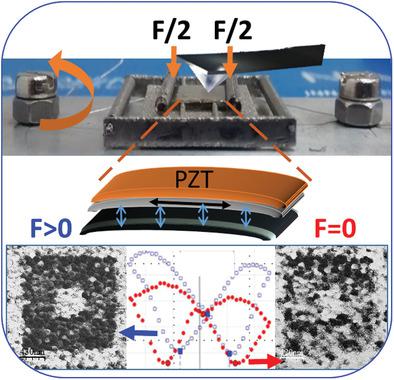当前位置:
X-MOL 学术
›
Adv. Electron. Mater.
›
论文详情
Our official English website, www.x-mol.net, welcomes your
feedback! (Note: you will need to create a separate account there.)
Enhanced Ferroelectric Functionality in Flexible Lead Zirconate Titanate Films with In Situ Substrate‐Clamping Compensation
Advanced Electronic Materials ( IF 5.3 ) Pub Date : 2019-07-23 , DOI: 10.1002/aelm.201900428 Rachel Onn Winestook,Cecile Saguy,Chun‐Hao Ma,Ying‐Hao Chu,Yachin Ivry
Advanced Electronic Materials ( IF 5.3 ) Pub Date : 2019-07-23 , DOI: 10.1002/aelm.201900428 Rachel Onn Winestook,Cecile Saguy,Chun‐Hao Ma,Ying‐Hao Chu,Yachin Ivry

|
Much attention has recently been given to flexible and wearable integrated electronic devices, with a strong emphasis on real‐time sensing, computing, and communication technologies. Thin ferroelectric films exhibit switchable polarization and strong electromechanical coupling, and hence are in widespread use in such technologies, albeit not when flexed. Effects of extrinsic strain on thin ferroelectric films are still unclear, mainly due to the lack of suitable experimental systems that allow cross structural–functional characterization with in situ straining. Moreover, although the effects of intrinsic strain on ferroelectric films, e.g., due to film–substrate lattice mismatch, have been extensively investigated, it is unclear how these effects are influenced by external strain. A method to strain thin films homogenously in situ is developed, allowing structural characterization as well as functional switching and piezorsponse measurements at the nanoscale, while retaining the sample under constant straining conditions. Using this method, thin films of PbZr0.2Ti0.8O3, which were grown on a flexible mica substrate, are strained to reduce substrate clamping effects and increase the tetragonality. Consequently, the domain stability is increased, the coercive field value is decreased, and imprint effects are reduced. This method also allows direct characterization of the relationship between the lattice parameters and nanoscale properties of other flexible materials.
中文翻译:

具有原位衬底钳位补偿的柔性锆钛酸铅钛薄膜中增强的铁电功能
最近,人们对柔性和可穿戴式集成电子设备给予了极大关注,其中特别强调了实时传感,计算和通信技术。铁电薄膜显示出可切换的极化和强机电耦合,因此尽管没有弯曲,但仍广泛用于此类技术中。外在应变对铁电薄膜的影响仍然不清楚,这主要是由于缺乏合适的实验系统,该系统无法通过原位应变进行跨结构-功能表征。而且,尽管已经广泛研究了固有应变对铁电薄膜的影响,例如由于膜-衬底晶格失配引起的影响,但尚不清楚这些效应如何受到外部应变的影响。开发了一种均匀地原位拉伸薄膜的方法,允许在纳米级进行结构表征以及功能转换和压电响应测量,同时将样品保持在恒定的应变条件下。使用这种方法,PbZr薄膜生长在柔性云母基板上的0.2 Ti 0.8 O 3受到应变,以降低基板夹持效果并增加四方性。结果,增加了域稳定性,减小了矫顽场值,并且减小了压印效果。该方法还可以直接表征晶格参数与其他柔性材料的纳米级特性之间的关系。
更新日期:2019-10-10
中文翻译:

具有原位衬底钳位补偿的柔性锆钛酸铅钛薄膜中增强的铁电功能
最近,人们对柔性和可穿戴式集成电子设备给予了极大关注,其中特别强调了实时传感,计算和通信技术。铁电薄膜显示出可切换的极化和强机电耦合,因此尽管没有弯曲,但仍广泛用于此类技术中。外在应变对铁电薄膜的影响仍然不清楚,这主要是由于缺乏合适的实验系统,该系统无法通过原位应变进行跨结构-功能表征。而且,尽管已经广泛研究了固有应变对铁电薄膜的影响,例如由于膜-衬底晶格失配引起的影响,但尚不清楚这些效应如何受到外部应变的影响。开发了一种均匀地原位拉伸薄膜的方法,允许在纳米级进行结构表征以及功能转换和压电响应测量,同时将样品保持在恒定的应变条件下。使用这种方法,PbZr薄膜生长在柔性云母基板上的0.2 Ti 0.8 O 3受到应变,以降低基板夹持效果并增加四方性。结果,增加了域稳定性,减小了矫顽场值,并且减小了压印效果。该方法还可以直接表征晶格参数与其他柔性材料的纳米级特性之间的关系。


















































 京公网安备 11010802027423号
京公网安备 11010802027423号